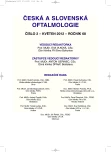Repeatability and Reliability of the Visual Acuity Examination on logMAR ETDRS and Snellen Chart
Authors:
P. Veselý; S. Synek
Authors‘ workplace:
Klinika nemocí očních a optometrie LF MU a FN u sv. Anny, Brno, přednosta doc. MUDr. S. Synek, CSc.
Published in:
Čes. a slov. Oftal., 68, 2012, No. 2, p. 71-75
Category:
Original Article
Overview
Purpose:
The main goal of our study was to prove the statistical significant correlation between repeated measurements and test-retest variability TRV expressed with confidence interval CI according to Bland-Altman’s method on 95% level of statistical confidence. The methods are threshold interpolation log MAR method on ETDRS chart, whole-line method on Snellen chart and modified threshold interpolation method on Snellen chart with Sloan letters.
Methods:
We had 468 measurements measured with threshold interpolation log MAR method on ETDRS chart, whole-line method on Snellen chart and modified threshold interpolation method on Snellen chart with Sloan letters. The average value of the first sequence of measurements measured with whole-line method on Snellen chart was -0.043 logMAR (min. 1, max. -0.30. SD 0.25) and of the second sequence of measurements was -0.045 logMAR (min. 1, max. -0.30. SD 0.23). The average value of the first sequence of measurements measured with interpolation method on Snellen chart was -0.018 logMAR (min. 0.98, max. -0.30. SD 0.29) and of the second sequence of measurements was -0.024 logMAR (min. 1, max. -0.80. SD 0.29). The average value of the first sequence of measurements measured with interpolation method on ETDRS chart was -0.0612 logMAR (min. 0.72, max. -0.30. SD 0.21) and of the second sequence of measurements was -0.0610 log MAR (min. 0.8, max. -0.28, SD 0.21).
Results:
We have proved that all methods do not have statistical significant difference between repeated measurements (Wilcoxon paired test, whole-line method on Snellen chart p = 0.74, interpolation method on Snellen chart p = 0.33 and interpolation method on ETDRS p = 0.95) and they also have statistical significant correlations (Spearman correlation coefficient, whole-line method on Snellen chart r = 0.91, p < 0.0001, interpolation method on Snellen chart r = 0.89, p < 0.0001 and interpolation method on ETDRS chart r = 0.89, p < 0.0001). TRV expressed with CI on 95% statistical significance level according to method of Bland-Altman was with whole-line method on Snellen chart ± 0.11 (i.e. 5 letters), with interpolation method on Snellen chart ± 0.20 (i.e. 10 letters) and with interpolation method on ETDRS ± 0.08 (i.e. 4 letters).
Conclusion:
In our study we proved that there is no statistical significant difference between repeated measurements with all three methods. After that we proved statistical significant correlations between repeated measurements with all three methods. The biggest clinical importance has determination and confirmation of the CI value of TRV. With interpolation method on ETDRS it was CI ± 0.08 (i.e. ± 4 letters), with whole-line method on Snellen it was CI ± 0.11 (i.e. ± 5 letters) and with interpolation method on Snellen it was CI ± 0.20 (i.e. ± 10 letters). Our recommendation based on results of our study is that is not clinically appropriate to convert measured values from Snellen optotype to logMAR and perform interpolation method on Snellen chart.
Key words:
visual acuity, threshold interpolation method, whole-line method, log MAR ETDRS chart, Snellen chart, letters of Sloan, test-retest variability
Sources
1. Arditi, A., Cagnerllo, R.: On the statistical reliability of letter-chart visual-acutiy measurements. Investig Ophthalmol and Vis Sci 1993; 34: 120–129.
2. Bailey, I., Lovie, J.: New design principles for visual acuity letter charts. Am J Optom Physiol Opt, 1976; 53: 740–745.
3. Bland, J., Altman D., G.: Statistical methods for assessing agreement between two methods of clinical measurement. Lancet, 1986; 1: 307–10.
4. Ferris, F., Kassoff, A., Bresnick et al.: New visual acuity charts for clinical research. Am J Ophthalmol, 1982; 94: 91–96.
5. Kaiser, P.K.: Prospective evaluation of visual acuity assessment: A comparison of Snellen versus ETDRS charts in clinical practice (An AOS thesis). Trans Am Opththalmol Soc, 2009; 107: 311–324.
6. Laidlaw, D., Abbott, A., Rosser, DA.: Development of a clinical feasible logMAR alternative to the Snellen chart: performance of the „compact reduced logMAR“ visual acuity chart in amblyopic children. Brit J Ophthalmol, 2003; 87: 1232–34.
7. Langrová, H., Hejcmanová, D., Peregrin, J.: How should visual acuity be measured? Čes a Slov Oftalmol, 1996; 52: 158–163.
8. Lim, L-A., Frost, NA., Powel, RJ., Hewson, P.: Comparison of the ETDRS logMAR, „compact reduced logMAR and Snellen charts in routine clinical practice. Eye 2010; 24: 673–677.
9. Manny, RE., Hussein, M., Gwiazda, J.: Repeatability of ETDRS visual acuity in children. Incest. Ophthalmol. Vis. Sci., 2003; 44: 3294–3300.
10. Peregrin, J., Hejcmanová, D., Kalinová, M., Svěrák J.: Czech national standards for visual tests. Čes a Slov Oftalmol., 1999; 65: 48: 48.
11. Rosser, D., Laidaw, D., Murdoch, I.: The development of a „reduced logMAR“ visual acuity chart for use in routine clinical practice. British Journal of Ophthalmology, 2001; 85: s. 432–436.
12. Rosser, D., Murdoch, I., Fizke, F.: Improving on ETDRS acuities: design and results for a computerised thresholding device. Nature-Eye, 2003; 17: 701–706.
13. Siderov, J., Tiu, AL.: Variability of measurement of visual acuity in a large eye clinic. Acta Opththalmol Scand, 77: 673–676.
14. Vanden Bosch, ME., Wall, M.: Visual acuity scored by the letter-by-letter or probit methods has lower retest variability than line assignment method, Eye, 1997; 11: 411–417.
18. Veselý, P., Ventruba, J.: Porovnání prahové interpolační a celořádkové metody při testování zrakové ostrosti na optotypových tabulích log MAR ETDRS a Snellen. Čes a Slov Oftalmol, 2009; 65: 191–194.
Labels
OphthalmologyArticle was published in
Czech and Slovak Ophthalmology

2012 Issue 2
Most read in this issue
- Repeatability and Reliability of the Visual Acuity Examination on logMAR ETDRS and Snellen Chart
- Acute Retinal Necrosis
- The Diabetic Macular Edema – New Possibilities of the Treatment
- Evaluation of Bacterial Colonization of the Conjunctival Sac in Ranibizumab Intravitreal Injections Treated Patients
